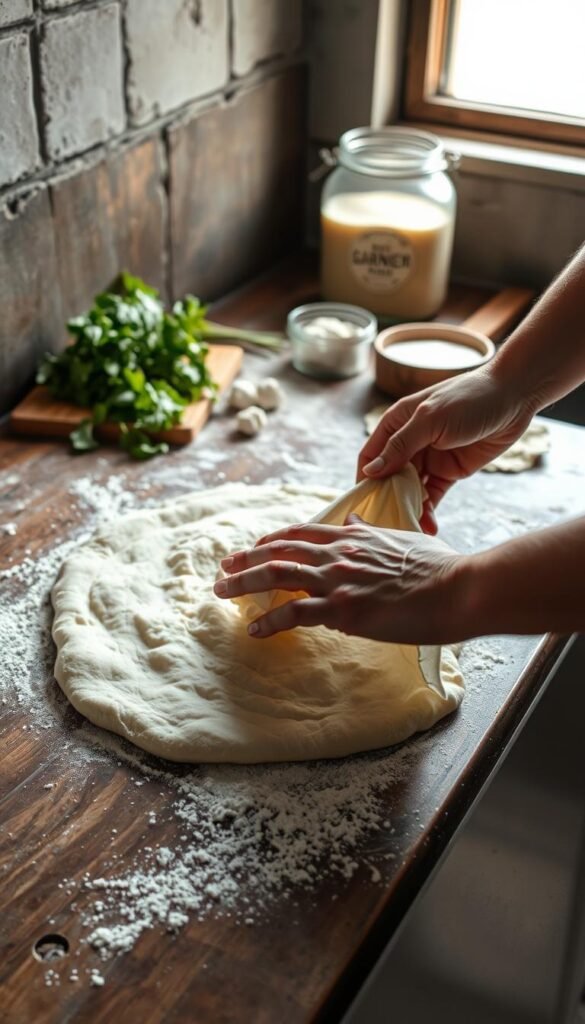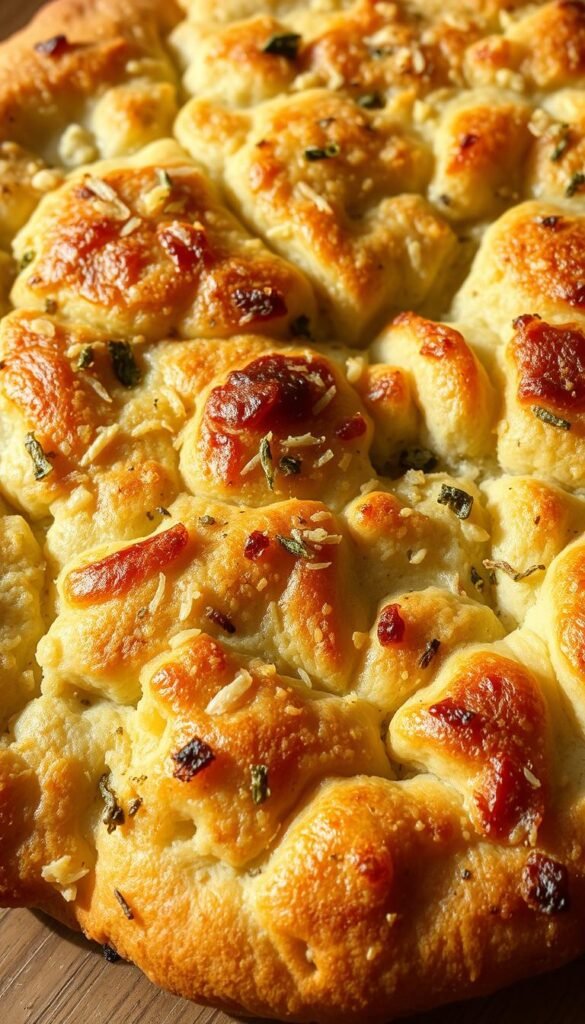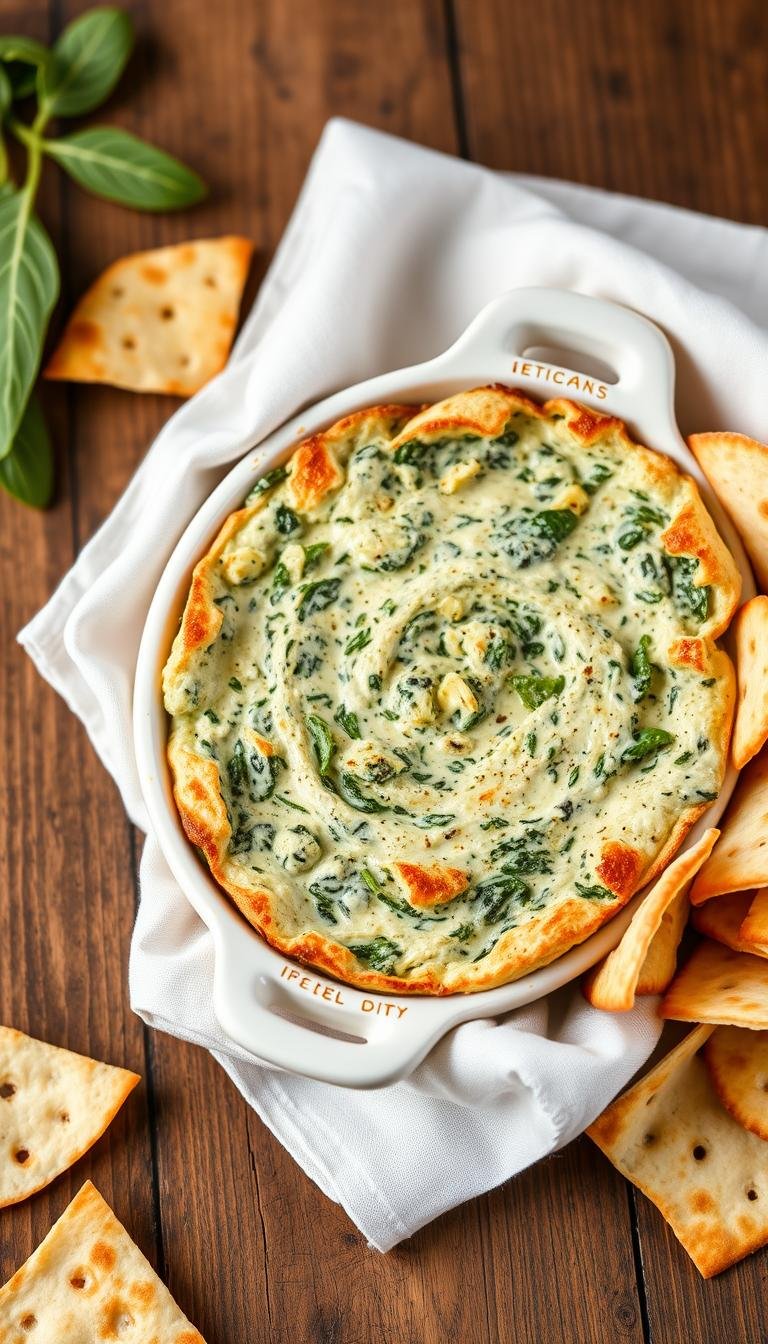20 Delicious Sourdough Pizza Dough Ideas
The art of crafting the perfect sourdough pizza recipe has captured the hearts of many home bakers and professional pizzaiolos. With its complex flavor profile and artisanal quality, homemade sourdough pizza has become a staple in many kitchens.
The process of creating artisan sourdough pizza involves understanding the fermentation process and mastering various techniques and flavor combinations. This comprehensive guide explores 20 creative variations on the classic sourdough pizza dough, inspiring you to elevate your homemade pizza game.
Key Takeaways
- Understanding the basics of sourdough pizza making
- Exploring creative flavor combinations for sourdough pizza
- Mastering techniques for a perfect sourdough crust
- Tips for adapting sourdough pizza recipes to different skill levels
- Ideas for creating restaurant-quality pizzas at home
The Art and Science of Sourdough Pizza
Sourdough pizza, with its tangy flavor and chewy crust, is a result of a carefully crafted process involving wild yeast and bacteria. This natural fermentation process not only contributes to its unique taste but also enhances its nutritional profile.
What Makes Sourdough Pizza Unique
The uniqueness of sourdough pizza lies in its fermentation process, which is facilitated by a natural starter culture instead of commercial yeast. This process involves wild yeast and lactobacilli, which break down the sugars in the dough, producing lactic acid and giving sourdough its characteristic tang.
The extended fermentation time also develops the gluten naturally, resulting in a more complex flavor profile and improved texture. Moreover, this process enhances the digestibility of the pizza by breaking down some of the gluten and phytic acid, making the nutrients more accessible to the body.
Essential Equipment and Ingredients
To make sourdough pizza, several pieces of equipment and ingredients are essential. A digital scale is crucial for precise measurements, while a mixing bowl and proofing container are necessary for the dough preparation and fermentation stages.
The choice of flour is also critical, with options like bread flour or all-purpose flour with a high protein content being preferred for their ability to produce a strong gluten structure. Water quality and salt type can also affect the final product, with filtered water and natural salt being recommended.
Maintaining a healthy sourdough starter is vital for sourdough pizza. This involves regular feeding and ensuring the starter is active and bubbly before using it in the dough. A pizza stone or steel is also necessary for achieving a crispy crust.
Foundational Sourdough Pizza Techniques
To craft exceptional sourdough pizzas, it’s crucial to grasp the fundamental techniques that govern the dough’s development. These techniques form the backbone of successful sourdough pizza making, allowing for the creation of a wide variety of delicious pizzas.
Classic Neapolitan-Style Sourdough Base
Creating a classic Neapolitan-style sourdough base involves a deep understanding of traditional Neapolitan pizza making, combined with the unique characteristics of sourdough fermentation. The process begins with a high-quality sourdough starter, which is the heart of any sourdough recipe.
The dough for a Neapolitan-style sourdough pizza typically consists of a simple mixture of flour, water, salt, and the sourdough starter. The ratio of ingredients is crucial, with a typical hydration level ranging between 60% to 65%. This relatively low hydration level contributes to the characteristic tender crust and soft center of Neapolitan pizzas.

Maintaining a healthy sourdough starter is essential for producing high-quality sourdough pizzas. This involves regular feeding of the starter, typically once a day, to keep it active and vibrant. The feeding schedule may need to be adjusted based on the environment and the starter’s activity level.
Proper storage of the sourdough starter is also important, especially for those who may not bake frequently. Storing the starter in the refrigerator can slow down its activity, allowing for less frequent feeding.
Perfect Hydration Levels
Achieving the perfect hydration level is critical in sourdough pizza making. The hydration percentage affects not only the dough’s workability but also the final texture of the crust. For a Neapolitan-style sourdough, a hydration level of around 60-65% is typical.
Understanding how to adjust hydration levels based on the type of flour used and the desired crust characteristics is key to mastering sourdough pizza techniques.
Overnight Cold Fermentation Method
The overnight cold fermentation method is a technique used to enhance the flavor and texture of sourdough pizzas. By slowing down the fermentation process through refrigeration, the dough develops a more complex flavor profile and becomes easier to shape.
This method involves mixing the dough in the evening, followed by a slow fermentation in the refrigerator overnight. The next day, the dough is ready to be shaped and baked, offering a convenient and flavorful approach to sourdough pizza making.
High-Hydration Sourdough for Extra Airy Crust
For those looking to create sourdough pizzas with an extra airy crust, high-hydration dough is the way to go. This involves increasing the water content to achieve a hydration level of 70-80%, resulting in a dough that is wetter and more challenging to handle.
The key to successfully working with high-hydration sourdough is developing the proper gluten structure through gentle handling and appropriate proofing times. The end result is a crust with large air pockets, characteristic of artisanal sourdough pizzas.
Whole Grain Sourdough Pizza Variations
Exploring whole grain sourdough pizza variations opens up a world of nutritional benefits and unique flavors. Whole grains bring a rich, complex character to sourdough pizza, enhancing both its nutritional profile and taste. By incorporating various whole grains into your sourdough pizza dough, you can create crusts that are not only delicious but also packed with fiber, vitamins, and minerals.
Whole Wheat Sourdough Pizza Base
Whole wheat sourdough pizza base offers a nutty flavor and denser texture compared to traditional white flour crusts. To achieve a balanced whole wheat sourdough base, it’s essential to adjust the hydration levels, as whole wheat flour tends to absorb more water than white flour. A typical ratio is to increase the water content by about 10% when using whole wheat. Additionally, whole wheat’s nuttier flavor pairs well with toppings like caramelized onions, roasted garlic, and fresh herbs.
Tips for making whole wheat sourdough: Use a higher hydration level to counteract the density of whole wheat flour. Consider autolyse (pre-mixing flour and water before adding other ingredients) to improve dough texture.
Rye Sourdough Pizza Crust
Rye sourdough pizza crust is known for its distinctive earthy flavor and dense texture. Rye flour contains less gluten than wheat flour, so it’s often combined with bread flour to improve the crust’s structure. The key to a successful rye sourdough crust is balancing the amount of rye flour with other flours to maintain a tender, yet crisp, crust.
Benefits of rye in sourdough pizza: Rye adds a unique flavor dimension and can lower the glycemic index of the crust. It’s also rich in fiber and contains various minerals.
Spelt and White Flour Blend
Using a blend of spelt and white flour in sourdough pizza dough combines the nutritional benefits of spelt with the lighter texture of white flour. Spelt flour has a slightly sweet, nutty flavor and is easier to digest for some people compared to modern wheat varieties. When blending spelt with white flour, a common ratio is 50/50, allowing you to benefit from spelt’s nutritional profile while maintaining a lighter crust texture.
Spelt characteristics: Spelt contains a different type of gluten that some people find more tolerable. It has a higher water-soluble fiber content and is rich in nutrients like copper and manganese.
Einkorn Ancient Grain Sourdough Pizza
Einkorn ancient grain sourdough pizza is made using one of the oldest forms of wheat, known for its rich nutritional profile and distinctive yellow color. Einkorn has a lower gluten content compared to modern wheat, requiring careful handling to achieve the right dough consistency. The flavor profile of einkorn is often described as rich and buttery, making it an excellent choice for those looking for a unique sourdough pizza experience.
Einkorn benefits: Einkorn is high in protein and contains a different type of gluten that may be easier to digest for some individuals. It’s also rich in antioxidants and has a higher content of certain minerals like potassium and phosphorus.
20 Delicious Sourdough Pizza Dough Ideas for Every Taste
The versatility of sourdough pizza dough allows for a wide range of creative flavor combinations, making it a perfect canvas for culinary innovation. By incorporating various ingredients directly into the dough, bakers can create distinctive pizza bases that elevate the entire pizza experience.
Garlic and Herb Infused Sourdough
Infusing sourdough with garlic and herbs is a straightforward way to add depth and complexity to your pizza crust. The key is to balance the flavors so that they complement the toppings without overpowering them.
Fresh vs. Dried Herbs
When it comes to choosing between fresh and dried herbs, both have their advantages. Fresh herbs provide a vibrant, bright flavor, while dried herbs offer a more concentrated taste. For a garlic and herb infused sourdough, you can use a combination of both, depending on the herbs you’re using and the flavor profile you desire.
| Herb Type | Fresh Quantity | Dried Quantity |
|---|---|---|
| Basil | 1/4 cup chopped | 2 tablespoons dried |
| Oregano | 1/4 cup chopped | 1 tablespoon dried |
| Rosemary | 2 tablespoons chopped | 1 teaspoon dried |
Roasted Garlic Technique
Roasting garlic mellows its flavor and brings out a sweet, nutty taste that pairs well with herbs. To roast garlic, cut the top off a whole head, drizzle with olive oil, and roast at 400°F (200°C) for about 30-40 minutes, or until soft and caramelized.

Rosemary and Sea Salt Sourdough Crust
A rosemary and sea salt sourdough crust is a classic combination that evokes the Mediterranean. The key to this flavor profile is using high-quality, flaky sea salt and fresh rosemary to create a crisp, aromatic crust.
Tips for the best results: Use a pizza stone in the oven to achieve a crispy crust, and sprinkle the sea salt just before baking to preserve its texture.
Spicy Chili Oil Sourdough Base
For those who enjoy a bit of heat, incorporating spicy chili oil into your sourdough can add a fascinating dimension. You can adjust the level of heat to your liking by using different types of chili peppers or adjusting the amount of oil used.
Complementary toppings: Balance the spiciness with toppings like mozzarella, fresh basil, or caramelized onions.
Caramelized Onion Sourdough Pizza Dough
Caramelizing onions brings out their natural sweetness, which pairs beautifully with the tanginess of sourdough. To incorporate caramelized onions into your dough, cool them completely after cooking to prevent affecting the yeast activity.
Technique: Cook the onions slowly over low heat, stirring occasionally, until they’re deep golden brown and caramelized.
Sweet and Savory Flavor Combinations
The versatility of sourdough pizza dough allows for a wide range of sweet and savory flavor combinations, transforming a simple pizza into a gourmet culinary experience. By incorporating unique ingredients and flavor profiles, you can create artisan sourdough pizzas that cater to various tastes and preferences.

Honey-Sweetened Sourdough for Dessert Pizzas
Incorporating honey into your sourdough dough can create a delicious base for dessert pizzas. To achieve this, you’ll need to adjust the hydration levels and fermentation times to accommodate the added sugar. Reduce the water content by about 10% to counterbalance the moisture from the honey. When it comes to toppings, consider pairing the honey-sweetened crust with fresh fruits, such as figs or apples, and a sprinkle of cinnamon or nutmeg.
- Use high-quality, pure honey for the best flavor.
- Adjust fermentation time: longer fermentation can help break down some of the sugars.
- Bake at a lower temperature to prevent burning.
Parmesan and Black Pepper Sourdough Crust
Adding Parmesan and black pepper directly to your sourdough dough can result in a crust that’s both savory and aromatic. The key is to balance the umami flavor of Parmesan with the subtle heat of black pepper. When incorporating aged cheese, consider the fat content and adjust your dough’s hydration accordingly.
- Grate the Parmesan finely to distribute evenly throughout the dough.
- Use freshly ground black pepper for optimal flavor.
- Monitor the dough’s hydration: aged cheese can add moisture.
Olive Oil and Herb-Infused Sourdough
Infusing your sourdough with high-quality olive oil and herbs like oregano, thyme, and marjoram can transport your pizza to the Mediterranean. The choice of olive oil can significantly impact the flavor, so opt for a robust, fruity oil. When combining olive oil with herbs, ensure the dough remains aromatic but structurally sound.
- Select a high-quality olive oil with a distinct flavor profile.
- Mix herbs into the dough during the final stages of mixing to preserve their aroma.
- Be mindful of the amount of olive oil: too much can make the dough too wet.
Sundried Tomato and Basil Sourdough Base
Sundried tomatoes can add a burst of intense flavor to your sourdough pizza base. To incorporate them effectively, rehydrate the tomatoes before chopping and adding them to the dough. Balance their rich flavor with fresh basil to create a harmonious taste experience.
- Rehydrate sundried tomatoes in warm water before use.
- Chop the rehydrated tomatoes finely to distribute evenly.
- Add fresh basil towards the end of mixing to preserve its freshness.
By exploring these sweet and savory flavor combinations, you can elevate your sourdough pizza game and create unique, gourmet pizzas that are sure to impress. Whether you’re making dessert pizzas or savory masterpieces, the right flavor combinations can make all the difference.
Unique Grain and Flour Combinations
By venturing beyond traditional flour, you can unlock new flavors and textures in your sourdough pizza. The art of combining different grains and flours allows for a wide range of possibilities, from subtle variations to bold innovations. This exploration into unique grain and flour combinations will guide you through creating distinctive sourdough pizzas that cater to various tastes and dietary preferences.

Kamut and Semolina Sourdough Crust
Combining Kamut (also known as Khorasan wheat) with semolina flour creates a sourdough crust that is both golden and slightly sweet, with an exceptional texture. To achieve this, use a ratio of 70% Kamut flour to 30% semolina. Adjust hydration levels to 70-75% to accommodate the higher absorption rate of Kamut. The fermentation process remains similar to traditional sourdough, but be prepared for a slightly longer proofing time due to the denser nature of Kamut.
Buckwheat Sourdough Pizza Base
Incorporating buckwheat into your sourdough pizza base introduces an earthy flavor profile and a darker color. To maintain structure, blend buckwheat with wheat flours at a ratio of 20-30% buckwheat to 70-80% wheat flour. Expect a denser crust with a nutty taste. Pair this earthy flavor with ingredients like mushrooms, caramelized onions, or goat cheese for a harmonious taste experience. Manage buckwheat’s unique properties by adjusting hydration and allowing for a longer fermentation time.
Cornmeal-Enhanced Sourdough Crust
Adding cornmeal to your sourdough crust can range from a subtle texture enhancement to a prominently corn-forward flavor. The type of cornmeal used (fine vs. coarse) significantly affects the final product. Fine cornmeal integrates more smoothly into the dough, while coarse cornmeal provides a more textured crust. Start with a 10-20% cornmeal substitution and adjust according to your preference. Be aware that cornmeal absorbs less water than wheat flour, so hydration adjustments may be necessary.
Multigrain Seeded Sourdough Pizza
Creating a multigrain seeded sourdough pizza involves incorporating various seeds like flax, sesame, sunflower, and pumpkin into your dough. These additions not only enhance the nutritional profile but also add texture and flavor. Pre-soak seeds in water or sourdough starter before adding them to the dough to prevent them from absorbing too much water during fermentation. Toasting seeds lightly before incorporation can also enhance their flavor. Aim for a total seed addition of about 10-15% of the total flour weight.
Special Dietary Sourdough Options
Sourdough pizza can be tailored to suit various dietary preferences, from vegan to lower-carb options, without losing its authentic charm. This adaptability makes it an ideal choice for those with specific nutritional needs or preferences.
Long-Fermented Sourdough for Better Digestibility
Long-fermented sourdough is known for its enhanced digestibility, making it a great option for those with gluten sensitivity. The extended fermentation process breaks down some of the gluten, resulting in a more easily digestible crust.
Timing Your Fermentation
The timing of your fermentation is crucial for achieving the best results. For long-fermented sourdough, a fermentation time of 24 to 72 hours is recommended. This allows for a more thorough breakdown of gluten and other compounds, enhancing digestibility.
- Monitor your dough’s progress, looking for signs of readiness such as doubling in size or a tangy aroma.
- Adjust fermentation time based on your environment and the specific characteristics of your dough.
Temperature Control
Temperature control is vital during the fermentation process. Ideally, the dough should be kept in a cool, draft-free environment. The optimal temperature range is between 65°F to 75°F (18°C to 24°C).
“Maintaining the right temperature is key to successful fermentation. Too high, and your dough may over-ferment; too low, and it may not ferment enough.”
Olive Oil-Enriched Vegan Sourdough Pizza Dough
Creating a vegan sourdough pizza dough enriched with olive oil is a great way to enhance flavor and texture. Olive oil not only adds richness but also helps to keep the dough moist.
| Ingredient | Quantity | Purpose |
|---|---|---|
| Flour | 500g | Base ingredient |
| Olive Oil | 50g | Enhances flavor and moisture |
| Water | 350g | Hydrates the dough |
| Sourdough Starter | 150g | Provides leavening and flavor |
Lower-Carb Sourdough with Alternative Flours
For those looking to reduce their carbohydrate intake, using alternative flours in sourdough pizza dough is a viable option. Flours such as almond flour, coconut flour, and vital wheat gluten can be used to create a lower-carb crust.
Key Considerations:
- Almond flour adds nutty flavor and reduces carbs.
- Coconut flour absorbs more water, so adjustments in hydration are necessary.
- Vital wheat gluten helps improve texture and structure.
Advanced Cooking Methods for Perfect Sourdough Pizza
The art of cooking sourdough pizza involves understanding and applying sophisticated cooking methods that yield professional-quality results. Whether you’re using a cast iron skillet, grilling your pizza, or baking in a home oven, the technique can significantly impact the final product.
Cast Iron Skillet Sourdough Pizza Method
Cooking sourdough pizza in a cast iron skillet is a popular method for achieving a crispy crust. The key to success lies in preheating the skillet properly and handling the dough with care. Preheat your cast iron skillet in the oven at 500°F (260°C) for at least 30 minutes before cooking. Then, carefully place your shaped sourdough pizza dough into the hot skillet, add your toppings, and bake for 12-15 minutes, or until the crust is golden and the toppings are cooked through.
To prevent burning, it’s essential to monitor the pizza closely during the cooking time. You can also rotate the skillet halfway through the cooking time to ensure even cooking.
Grilled Sourdough Pizza Technique
Grilling sourdough pizza can add a smoky flavor and a charred crust that many pizza enthusiasts love. To grill sourdough pizza successfully, preheat your grill to medium-high heat, around 425°F to 450°F (220°C to 230°C). For gas grills, preheat with the lid closed. For charcoal grills, ensure the coals are evenly distributed and at the right temperature.
Place the dough on a piece of parchment paper or a lightly floured pizza peel, if you have one. Slide the dough onto the grill grates, close the lid, and cook for 2-3 minutes on the first side, or until the crust starts to set and shows grill marks. Flip the dough, add toppings, and cook for an additional 2-3 minutes, or until the toppings are heated through and the crust is cooked.
| Grill Type | Preheat Temperature | Cooking Time (First Side) | Cooking Time (Second Side) |
|---|---|---|---|
| Gas Grill | 425°F – 450°F | 2-3 minutes | 2-3 minutes |
| Charcoal Grill | 425°F – 450°F | 2-3 minutes | 2-3 minutes |
Adapting Sourdough for Home Ovens vs. Pizza Stones
Cooking sourdough pizza in a home oven can be done using various methods, including pizza stones, steels, or specialized pizza ovens. Each method has its advantages. A pizza stone or steel can help achieve a crispy crust by absorbing moisture and distributing heat evenly.
Preheat your pizza stone or steel in the oven at 500°F (260°C) for at least 30 minutes before cooking. Slide your shaped sourdough pizza dough onto the preheated stone or steel, add toppings, and bake for 12-15 minutes, or until the crust is golden.
For those without a pizza stone or steel, a regular oven rack can still produce great results. Use a baking sheet or a cast iron pan to cook the pizza, and adjust the cooking time as needed.
| Oven Setup | Preheat Temperature | Cooking Time |
|---|---|---|
| Pizza Stone/Steel | 500°F | 12-15 minutes |
| Baking Sheet/Cast Iron | 425°F – 450°F | 15-20 minutes |
By mastering these advanced cooking methods, home bakers can achieve professional-quality sourdough pizzas that rival those from artisan bakeries.
Conclusion: Mastering Your Sourdough Pizza Journey
As you’ve explored the various techniques and recipes throughout this article, it’s clear that sourdough pizza making is both an art and a science. The unique flavor development, improved digestibility, and artisanal quality that come from natural fermentation make sourdough pizza a rewarding culinary pursuit. By mastering the foundational techniques, experimenting with different flavor combinations, and adapting to various cooking methods, you’re well on your way to creating your own signature sourdough pizza recipe.
As you continue on your sourdough pizza journey, don’t be afraid to experiment and combine elements from different variations to create your own gourmet pizza dough. With the knowledge gained from this article, you’re equipped to tackle common challenges and troubleshoot issues that may arise. For those looking to deepen their expertise, numerous resources are available, including recommended books, online communities, and courses on homemade sourdough pizza making.
Embarking on this sourdough pizza journey not only connects you to traditional food practices but also provides a creative outlet that yields delicious results. By sharing your creations with others, you’ll experience the satisfaction of mastering a valuable culinary skill. Whether you’re a seasoned baker or just starting out, the world of sourdough pizza making offers endless possibilities for exploration and enjoyment.






